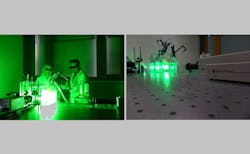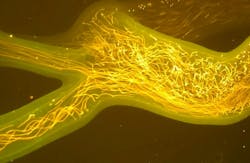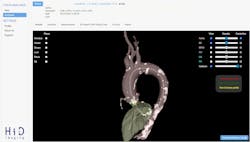Case study: Laser light enables digital twin technology in cardiology
Our heart is a complex system. When it shows weaknesses, identifying and addressing the causes can be quite challenging. Swiss startup Hi-D Imaging aims to change this. Led by Dr. Utku Guelan, the team is pioneering research in cardiovascular hemodynamics by combining optical measurements and digital twins.
Optical measurement techniques such as particle imaging velocimetry (PIV) and particle tracking velocimetry (PTV) are at the core of digital twin generation by Hi-D Imaging. Using silicone models based on computer tomography scans, they conduct 3D measurements at their Digital Twin Lab in Winterthur, Switzerland, to deliver data for cardiovascular risk assessment. In 2025, the company received FDA approval for the first module of their Cardiovascular Imaging Suite, a cloud-based AI-powered platform.
MKS provides two products that enable this research: a Spectra-Physics Millennia laser to illuminate tracer particles, and a Newport optical table to ensure stability of the measurement setup.
Products
- MKS Spectra-Physics Millennia eV high-power, continuous-wave diode-pumped solid-state laser (25 W)
- MKS Newport Integrity 2 VCS optical table
Market
- Medical device testing
- Medical research
Application
- Particle tracking velocimetry (PTV)
- Particle imaging velocimetry (PIV)
- Digital twins
Laser
- Lightweight, robust
- Easy to handle
- Powerful laser to fluoresce tracer particles
Optical table
- Good broadband vibration
- No sidewall resonance
- Integrated damping layer
Data-based decisions for cardiovascular diseases
Cardiovascular diseases (CVDs) are the leading cause of death worldwide. 20.5 million people died from CVDs in 2021, which represents about one third of all global deaths. Hi-D Imaging is dedicated to measuring and analyzing blood flow characteristics, because these are key indicators of cardiovascular function. Based on its research, the company creates sophisticated solutions to optimize and standardize cardiovascular treatment.
The team combined physical measurement, digital analysis, and artificial intelligence to create two first-of-their-kind solutions: The FDA-510K-cleared module of Hi-D’s Cardiovascular Imaging Suite, 4TAVR software, automates anatomical measurements and simplifies preoperational planning in hospitals. The Digital Twin Lab service platform supports in-depth research for the development of new medical devices as well as for individual cardiovascular risk assessment. The novel in vitro imaging methods, fluid dynamics know-how, and state-of-the-art computer vision techniques are the key components of Hi-D’s digital twin technology.
Laser light reveals particle motion
Hi-D’s innovative technology is based on Guelan’s research during his Ph.D. studies at ETH Zurich during the early 2010s. This is when he started using the 3D-PTV performed in anatomically accurate silicone aortic phantoms. Guelan and colleagues have applied this novel technology to different cardiovascular diseases and published more than >70 scientific papers in high-impact journals and at conferences during the last decade.
The sophisticated digital twin technology uses “physical” optical measurements as an input. The first step is to make anatomically accurate silicone models based on computer tomography scans of the relevant arteries. To perform realistic in vitro measurements and create a digital twin, the team replicates the relevant in vivo conditions using pulse duplicators.
The experimental optical setup comprises the silicone model, a pulse duplicator to mimic the function of the heart, and the laser system. For the in vitro measurements, the researchers use a fluid mixture composed of glycerin, water, and sodium chloride (NaCl) that mimics the physical properties of blood. Fluorescent rhodamine particles are added to this fluid mixture. And it’s where the laser comes into play: Laser light causes the particles to fluoresce, and a high-resolution camera captures the particle motion. “Illuminating the particles is key to this technology. The pictures not only look artistic but also show the flow within different diseased models and allow us to build and analyze the digital twin,” Guelan explains.
Core requirements of the laser
To visualize tracer particles within the fluid, the researchers use a 532-nm green laser for illumination. As the particles are traced with a camera that captures ~5000 to 6000 fps, at least 20-W continuous laser power is required. During his studies at ETH Zurich, Guelan used a Spectra-Physics laser. As the technology evolved and he started his own business, he reevaluated the market and discovered that particles can only be traced with reliably stable laser power. At the same time, a light and mobile laser was necessary for his experimental setup. After testing several lasers and comparing the properties, he selected the 25-W Spectra-Physics Millennia eV laser because it met all his requirements.
Installation of the Millennia eV laser underpinned this decision. Within just a few hours, the team performed their first measurements. The laser met all specified technical requirements, ensured the Hi-D Imaging team complied with the latest ISO standards, and is also very quiet. The laser perfectly suited their application. The technical team at Spectra-Physics was extremely supportive.
Performing sensitive measurements to simulate blood flow requires a superior working surface. So Hi-D Imaging turned to MKS to explore options for optimal vibration control. All measurements within their lab are performed on a Newport Integrity VCS optical table system that features a sturdy and multifunctional support frame designed to maximize utility, minimize space occupied, and optimize structural rigidity. Due to the stiffness of the platform, the sensitive measurement setup can be used without any optical disturbances.
Game-changer beyond cardiology
In vitro measurements are noninvasive, bear no risks to patients, and deliver reliable data to healthcare stakeholders. Clinical studies showed 90% agreement between the digital twin-based hemodynamics measurements and 4D magnetic resonance imaging (MRI) flow-based hemodynamics analysis. With FDA approval of the Hi-D Imaging 4TAVR software that provides fully automated anatomical measurements to perform pre-procedural transcatheter aortic valve replacement (TAVR) planning, a major step forward was made. “In vitro-powered digital twins are revolutionizing medical research. We will expand our lab quantities soon to be able to perform more measurements, and look forward to working with the MKS team again,” Guelan says.
SOURCE
1. M. Di Cesare et al., Glob. Heart, 19, 1, 11 (Jan. 25, 2024); doi:10.5334/gh.1288.
About the Author
Dagmar Ecker
Independent PR Specialist
Dagmar Ecker is a PR expert and trade journalist based in Germany with over 25 years of experience in B2B communication. She specializes in mechanical engineering and information technology. Holding a degree in Industrial Engineering, she combines deep industry insight with technical knowledge.



